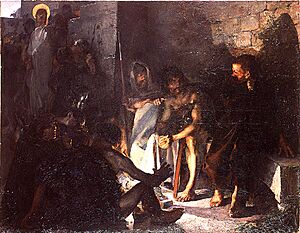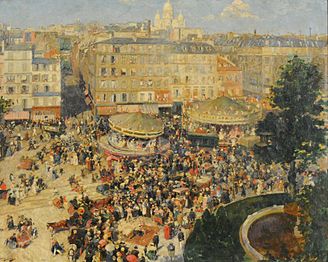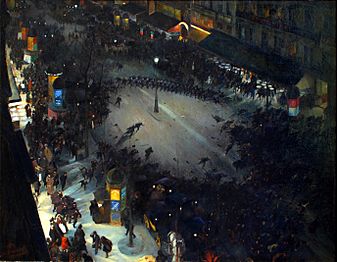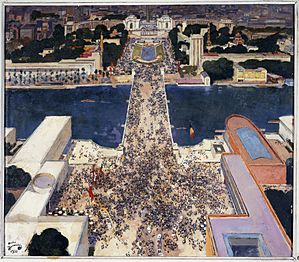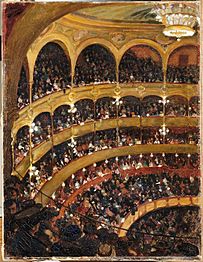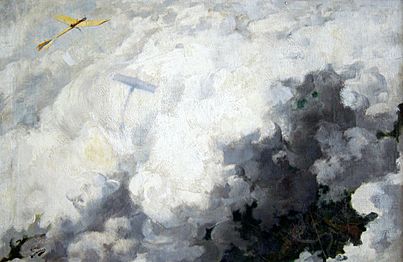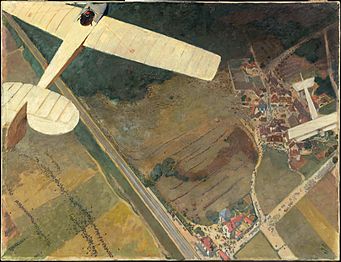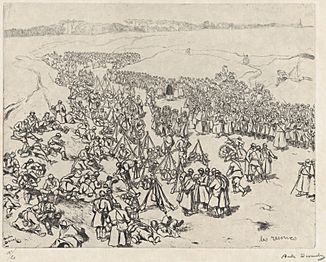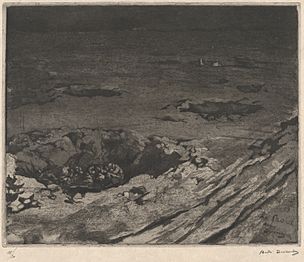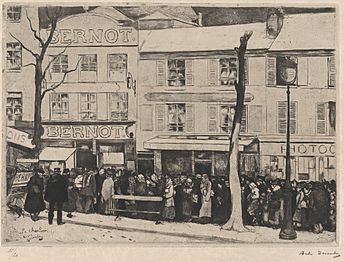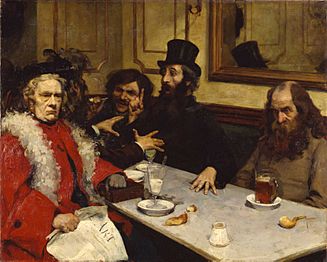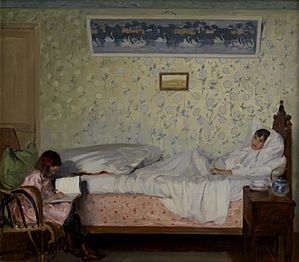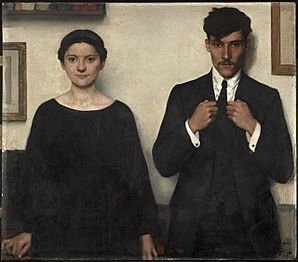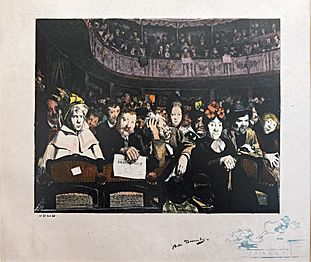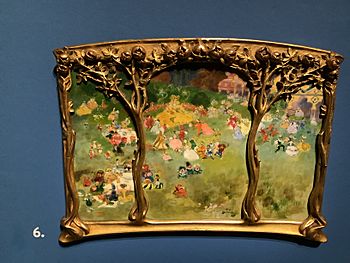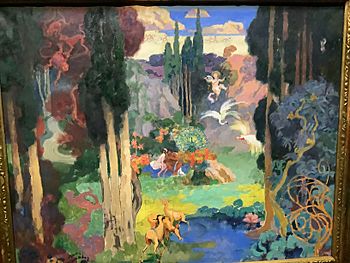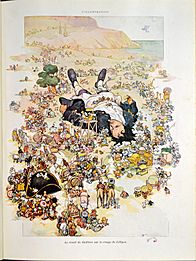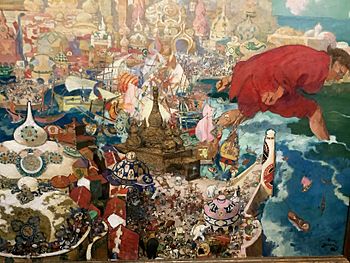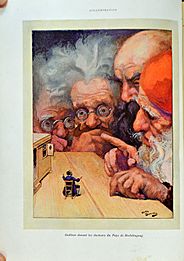André Devambez facts for kids
André Devambez (born May 26, 1867 – died March 18, 1944) was a talented French artist. He was known for his fun drawings in children's books. He also painted exciting scenes of Paris and early airplanes, often from a high-up view. Devambez was a professor at a famous art school, the École des Beaux-Arts. He was also part of the French Académie des Beaux-Arts and received the Legion of Honor award. Today, you can see some of his paintings at the Musée d'Orsay in Paris.
Contents
Biography
André Devambez was born on May 26, 1867. His father, Édouard Devambez, started as an engraver. He and André's mother, Catherine Véret, opened their own art studio in 1870. This studio, called the Maison Devambez, grew into a big publishing company. They sold engravings and other art.
From a young age, André wanted to be an artist. He took private lessons from Gabriel Gouray, a former student of Jean-Léon Gérôme. Later, he studied with Jules Joseph Lefebvre at the Académie Julian. In 1885, he passed the entry exam for the École des Beaux-Arts. There, he learned from famous artists like Jean-Joseph Benjamin-Constant and Gustave Boulanger.
In 1890, André won the Prix de Rome. This was a special award that allowed him to study and paint for five years in Rome, Italy, at the Villa Médicis. His studies were paused for a while when he served in the military. He went back to Rome in 1893. For one of his required paintings, "The Prodigal Son," he even used a camera to pose for the figures himself!
He continued to create large, important paintings. In 1898, his work "The Conversion of the Madeleine" earned him a Second Class Medal. In 1900, he married Cécile Richard, and they had two children, Pierre and Valentine. He became a member of the Société des Artistes Français in 1899. In 1905, he was made a knight of the Légion d'honneur.
Devambez also started illustrating books and making smaller artworks. In 1898, he illustrated a novel by Émile Zola. In May 1913, he had his first solo art show.
When World War I began in 1914, André was too old to join the army. But he volunteered to be a battlefield artist. He also helped paint camouflage to hide army positions. On June 3, 1915, he was badly hurt in the leg and left eye by a German shell. He spent a long time recovering in the hospital. In August 1915, he received the Croix de Guerre award for his bravery.
In 1929, he became the head of the painting section at the École des Beaux-Arts. This was France's most important art school. He was the first to allow women students into the painting workshop. That same year, he was elected to the Académie des Beaux-Arts, where he stayed until he died.
In 1934, Devambez was given a special job: official painter for the Ministry of Aviation. He used his art to show how much aviation was growing. He also painted the 1937 Paris International Exposition from high up on the Eiffel Tower. These paintings gave a new and exciting view of the event. In 1938, he became a Commander in the Legion of Honor.
André Devambez passed away at his home on March 18, 1944, when he was 77 years old.
Paintings
Painting Paris and the Parisians
-
La Charge (1902–1903), Musée d'Orsay
Devambez often painted Paris and its people. He liked to show them from unusual angles, especially from above. When he was young, he lived on the sixth floor of a building. From there, he could see the busy streets of Paris below him. This view inspired many of his paintings.
Nine of his artworks are in the Musée d'Orsay in Paris. One of his most famous is La Charge (The Charge). This dramatic painting from 1902 shows a police charge against striking workers on the Boulevard Montmartre at night. It's seen from high above. Even though Devambez supported the workers, the painting ended up in the office of the police chief who ordered the action!
In 1937, he was asked to paint an aerial view of the new Palace of Chaillot for the Paris International Exposition. He painted it from the second level of the Eiffel Tower. It shows huge crowds on both sides of the Seine River and on the bridge. The painting uses a lot of blue, which was the official color of the Exposition. This painting is now in the Museum of Fine Arts in Rennes.
Aviation and Technology
-
"The only bird which flies above the clouds" (1910), Musée d'Orsay
Devambez loved painting scenes of modern life and new technology, especially airplanes. In 1909, he made a colorful print of a "Dirigible-Bus." This was a fun, imaginary vehicle that looked like a Paris bus combined with a balloon. Between 1909 and 1910, he went to air shows and drew airplanes. He often showed them as if seen from high above. These drawings appeared in popular magazines like "L'Illustration."
In 1910, he was asked to create twelve decorative panels for the new French Embassy in Vienna. He chose to paint modern inventions like the metro, buses, airships, and airplanes. He finished the designs, but the project was stopped due to money problems. The smaller panels he made were saved. They were finally put in place at the Vienna Embassy in 1993.
One painting from this series is at the Musée d'Orsay. It's called Le seul oiseau qui vole au-dessus des nuages ("The only bird that flies above the clouds"). It shows a biplane flying high above the clouds. You can see glimpses of the ground far below and the plane's shadow on the clouds.
Besides airplanes, Devambez also drew the new Paris Metro, showing crowds on the platforms. He also made funny cartoons of early car shows and races, like the Paris-Berlin race in 1901.
The First World War
-
Etching of front lines in the First World War (1917) (Metropolitan Museum of Art)
When World War I started in 1914, Devambez was 47. He was too old to be drafted, but he volunteered to be a combat artist. He also helped paint camouflage. He made several trips to the front lines. On June 3, 1915, he was badly hurt by an exploding German shell.
His first war paintings were based on photos and were quite formal. But in 1917, he published an album of twelve etchings. These were based on his own experiences at the front. They were much more dramatic and personal. The etchings showed scenes like "Cold," "Shell Holes," "The Fire," and "The Spy." He often showed these scenes from a high-up view.
Portraits
Lithographs - The Parisians
The "Tout-Petits" and "Ulysses and Calypso"
The "Tout-Petits" were very small paintings made by Devambez. They usually told a short story or a joke. These paintings were only a few centimeters big. Sometimes, they were put in very fancy frames. They became like a mix between a sculpture and a painting.
In 1936, during the Great Depression, Devambez faced some money problems. He went back to his earlier style to create a large, colorful painting. It was based on the Greek story of Ulysses and Calypso. The Museum of the Petit Palais bought this artwork.
Book Illustration
André Devambez also created illustrations for books and magazines. He made a children's book called Auguste a Mauvais Caractère (1913). André's own drawings for this book were hand-colored by a master of stencil art, Jean Saudé. This was the first of several children's books he made. These stories were probably for his son, Pierre Devambez (1902–1980), and his daughter Valentine (1907–?). His son later became an archaeologist and a curator at the Louvre museum.
Some other books illustrated by André Devambez include La Fête à Coqueville by Émile Zola (1899) and Les Condamnés à Mort by Claude Farrère (1920). He also drew for magazines like Le Figaro Illustré, Le Rire, and L'Illustration.
His work was shown in a special exhibition at the Musée de Beauvais in 1988. A large show of his paintings and illustrations was also held at the Petit Palais museum in Paris in 2022.


